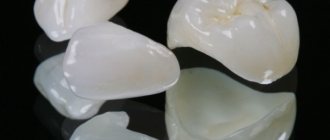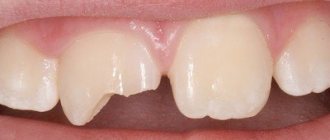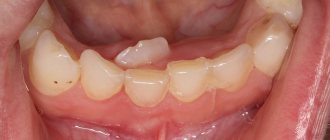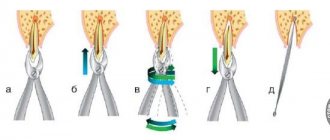- home
- Services
- Dental restoration for children
Baby teeth appear in a child from 6-9 months and are replaced by permanent teeth until the age of 12-14 years. Children's teeth, especially at an early age, are very vulnerable and susceptible to decay. It is careful attention to baby teeth that is the key to timely and correct growth of permanent dentition. A child with straight and beautiful teeth develops chewing and facial muscles correctly. Premature loss of even one baby tooth, untreated caries, crown injuries lead to the following problems:
- increased load on neighboring teeth;
- violation of growth order;
- deformations of the entire dentition;
- the occurrence of diction defects;
- deterioration of chewing function;
- aesthetic defects.
Changing the position of the rudiments of permanent teeth is a high risk of serious malocclusion, which is fraught with serious orthodontic treatment in the future. Natadent clinic specialists fight for every child’s tooth.
What is dental restoration
Restoration of baby teeth in children is carried out in the following cases:
- for damage caused by trauma;
- due to complicated caries.
Dental injuries in childhood are common. At the children's dental clinic "Natadent" we are ready to provide timely and qualified assistance. According to statistics, every third child suffers a tooth injury during sports games or vigorous activity.
By acting correctly, you can even save a knocked out tooth:
- Regardless of the severity of the injury, you should come for an examination to a pediatric dentist;
- take a photo to assess the nature of the damage;
- if displaced, the tooth must be strengthened by applying a splint or in another way at the discretion of the doctor;
- Deliver the child, along with the knocked out tooth, to the dentist’s office within 30 minutes.
Important! A knocked-out tooth cannot be picked up by the root, washed with water or treated with antiseptic solutions - this can make the process of its healing impossible and complicate restoration. It must be carefully taken by the crown and placed in saline solution, on the child’s cheek or in another biological environment.
If a piece of enamel breaks off from an injured tooth and dentin is exposed, then it cannot be left in this form. It is necessary to see a dentist and restore the damaged edge. Through a thin layer of dentin, pathogenic bacteria will enter the pulp and cause pulpitis. This can lead to tooth decay and costly treatment.
The Natadent clinic has all the possibilities for preserving teeth, restoring them and restoring them. We are sure that tooth injury is not a reason for losing it.
Restoration of baby teeth
If a child’s baby tooth breaks off or if the dental crown is severely damaged by caries, restoration is carried out. However, if for adult patients one of the most important aspects during restoration is aesthetics, then for children functionality is much more important. Therefore, restorative filling materials are always selected taking into account the patient’s age - for children, durability and impeccable aesthetics are not so important, a good marginal fit of the fillings and the preservation of dental tissues are much more important. Filling materials that are too strong can put pressure on dental tissues and contribute to their destruction, and therefore dentists choose materials that will recreate and maintain the integrity of the dental crown until the moment of natural tooth loss.
Recovery methods
Several methods can be used to restore a child's teeth. The type of restoration is chosen by the dentist depending on the nature and degree of destruction.
The difficulty of a dentist’s work during the process of tooth restoration is that children quickly get tired due to the need to remain static in a chair. Therefore, the Natadent Children's Dental Clinic provides the possibility of dental treatment under local anesthesia, general anesthesia or inhalation sedation.
Sealing
If a tooth is partially damaged, the dentist evaluates the condition of the remaining hard tissues and the quality of the soft tissues around the crown and roots. The following filling options are possible:
- treatment of the canals of a baby tooth and placing a filling at the gum level so that the tooth is not in the bite and does not experience stress;
- restoration using filling material.
Light-curing composite materials have many advantages:
- the dentist can completely build up a child’s tooth and recreate the crown relief;
- the chewing surface becomes durable;
- there is no release of harmful substances into the child’s body;
- the material hardens under UV light;
- You can achieve a high cosmetic effect and the required degree of transparency of the filling.
To prevent the formation of cracks during the life of the child and during shrinkage, the dentist forms a filling when building up layer by layer. The composite has the ability to hermetically close any microcracks and firmly connect to dentin.
Light-composite materials are a real innovation in dentistry, with the help of which filling and restoration of teeth has become less traumatic and most effective.
Crown installation
Carrying out this procedure in children is surprising, but not among the specialists at the Natadent clinic.
It is recommended to use the following method:
- for large chips;
- with significant tooth destruction of 50% or more.
If the chewing surface and one of the side walls of the tooth are lost, the remaining thin walls will not withstand the chewing load for a long time.
Installing a crown is a reliable way to save a baby tooth from destruction and maintain its functionality until it is replaced with a permanent one.
Crowns help:
- chew food thoroughly, which is important for the vulnerable gastrointestinal tract system;
- prevent the appearance of persistent speech defects, which is especially important during the period of active development of the child and preparation for school;
- form the correct bite.
Timely protection of teeth with crowns is an opportunity to minimize further destruction of baby teeth, the development of secondary caries and prevent improper development of permanent teeth.
Natadent pediatric dentistry uses two types of crowns:
- ceramic for the front teeth, which do not differ from natural incisors in color and shape and do not violate the aesthetics of the smile;
- metal, made of stainless steel, which are the ideal solution for restoring the function of chewing teeth.
Modern crowns are high-quality products with a unique design; they do not require significant grinding of the tooth, but significantly prolong its life. At the clinics of the Natadent network, we restore teeth for children in the same aesthetic and beautiful way as for adults.
Treatment of baby teeth
At the initial stages, caries is treated without tissue preparation - remineralization of the enamel, as well as modern Icon technology, which allows filling without drilling, easily cope with carious lesions of the enamel layer. In later stages, when the dentinal layer is affected, as well as in the case of pulpitis and periodontitis, treatment of baby teeth with tissue preparation will be required. You should not be afraid of such procedures - modern methods of anesthesia allow them to be carried out completely painlessly and comfortably for a small patient. In addition, the anesthetics used are harmless, with a minimum concentration of the active substance. And the site of the upcoming injection itself is numbed by applying a special gel or spray (application anesthesia).
Experienced dentists try to carry out treatment quickly so that the child does not have time to get tired and capricious. If a child has bad baby teeth and a large amount of work is required, it is divided into several stages. It also happens that the child does not want to contact the doctor, is too afraid of treatment, or the volume of manipulation is too large and serious - in such a situation, it is possible to carry out therapy under anesthesia or with intravenous sedation (with a preliminary examination).
In case of pulpitis, the root canals are filled with special pastes that dissolve simultaneously with the “milky” root, so there is no chance that the medicinal material will remain in the tooth socket and will prevent the new tooth from growing properly.
Reviews
Your feedback is to help potential patients make the right choice. Leave your suggestions or comments so we can work even better.
LEAVE FEEDBACK
How to protect baby teeth from caries?
Prevention is the best way to cope with any disease. Therefore, those parents who care about the health of their children should definitely think about caries prevention. How to protect baby teeth from caries? The recommendations of experts in this matter are as follows:
- The correct diet for the mother during pregnancy is with a sufficient amount of foods containing calcium, fluorine and phosphorus: cottage cheese, beef and beef liver, sea fish, nuts, fruits and vegetables, cereal porridges.
- Compliance with hygiene standards: daily brushing from the moment the first teeth appear, first with a cotton or gauze swab with boiled water, then with special baby brushes and pastes. Plaque on baby teeth should be removed promptly and thoroughly.
- A healthy diet for a child: as little fast carbohydrates, carbonated drinks, sweets as possible, more fruits and vegetables, cereals, and dairy products.
- Timely visits to the dentist for preventive examinations (at least once every six months).
It is important that parents develop a conscious attitude towards the health of their children's teeth and oral cavity in general. A timely visit to the dentist in case of any identified problems, as well as for regular medical examinations, will help maintain the health of the child’s dental system – and therefore the digestive system too.
Indications and contraindications
There are quite a few cases in which prosthetics of baby teeth is indicated.
Here are the main ones:
- destruction of more than 40% of the coronal part by caries;
- loss of milk long before the date of its replacement with a permanent one;
- chipping of enamel as a result of injury;
- fluorosis with destruction of enamel;
- underdevelopment of the enamel layer;
- violation of the aesthetics of the dentition (wide gaps, crowding).
There are no absolute contraindications to the procedure in children. There are only relative contraindications.
These include:
- allergic reactions to filling material;
- lack of necessary oral hygiene;
- the baby’s condition does not allow for long-term treatment and recovery;
- they require treatment before recovery;
- bruxism;
- restored units will interfere with the eruption of permanent ones.
Even if your child has contraindications, you can choose the optimal type of restoration.
How is prosthetics performed in children?
This method implies that dentures are not created directly, but in a dental laboratory. First, for this purpose, impressions of the child’s jaws are taken. If with direct restoration one visit to the doctor is enough, then here you will have to visit the dentist at least twice. However, the result will be worth it.
There are several types of prostheses for children:
- non-removable structures: these include crowns, pins, inlays and bridges that are fixed to their teeth,
- removable and conditionally removable dentures: if one, several or all teeth are missing (for example, with congenital pathology), then clasp devices or dentures made of soft plastics can be fixed in the oral cavity to properly form the child’s bite. This method of restoration is temporary, and the prostheses must be adjusted taking into account the child’s growth. This option is only suitable if a tooth is missing along with its root, when it is impossible to install other dentures - there is no base.
Types of damage and consequences of chips
Chip of tooth enamel or microcrack
As a result, the integrity of the upper dental layer is compromised, or its particles are separated. In most cases, such damage is barely noticeable and does not cause pain to the person; experts classify these defects as mild, and people prefer not to go to the dentist with such “nonsense.” However, places where the integrity of the enamel is damaged may be subject to various stresses, which provoke the development of pathogenic microflora, carious lesions and the activity of pathogenic microorganisms.
Vertical and horizontal cracks
Chipped tooth with dentin fracture
Considered to be a moderate injury. Such damage may not be accompanied by pain, or may cause discomfort and unpleasant sensations to external stimuli: hot or cold food, sour or sweet foods. Dentin is the inner tissue of the tooth and is inferior in strength to enamel, therefore, if the lost part is not built up in time, the dentin will begin to crumble, which can lead to tooth loss. From an aesthetic point of view, even a small chip in a front tooth can significantly reduce the attractiveness of your smile.
Deep fracture of the tooth to the pulp tissue with exposure of the nerve
This type of injury is considered the most severe, often accompanied by a split tooth into two parts, profuse bleeding and sharp pain, reminiscent of the torture of the Spanish Inquisition, and even painkillers only temporarily dull the pain. In such cases, delay can be fraught with inflammation and the development of infection.
What problems does artistic restoration solve?
The main goal of restoration is to restore the aesthetic appeal of the smile. Due to caries, the enamel and dentin of the tooth are damaged, which requires a filling procedure with special materials. Also, restoration may be required for previously poorly installed fillings that are irregular in shape and prevent normal jaw closure.
Restoration can also help in case of non-carious lesions of the child’s teeth, for example, fluorosis, aplasia, hypoplasia, etc. These pathologies can lead not only to external changes, but also to the appearance of functional disorders. These diseases cause rapid destruction of once healthy units, so you should consult a doctor as quickly as possible.
Also, artistic restoration is an excellent solution for discoloration (different colors of individual teeth due to a previous disease or serious injury to the jaw), when there is a strong difference in the size and shape of teeth, when there are large gaps in a row, and in many other cases. There are many methods for eliminating these deviations from the norm; the choice of a specific one depends on the clinical picture of the patient.
How do you know when it's time to see a doctor?
Tooth enamel hypoplasia is a disease that is difficult to miss. The child has the following symptoms:
- Deterioration of the enamel. The top layer of teeth becomes thinner and cracks appear on it;
- A carious layer appears on the teeth;
- The baby suffers from tooth sensitivity: he reacts to cold, hot, sweet.
Despite the fact that tooth enamel is the strongest tissue in the body, it cannot regenerate on its own. If symptoms of thinning are detected, parents should consult a doctor with their baby as soon as possible.











